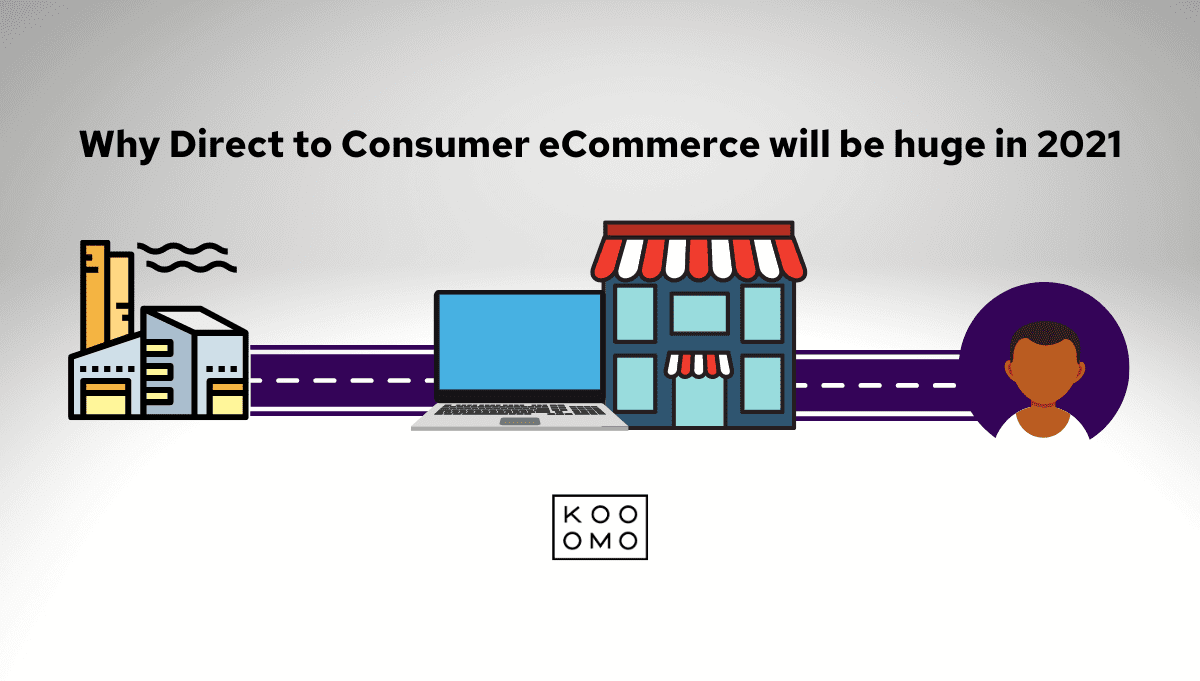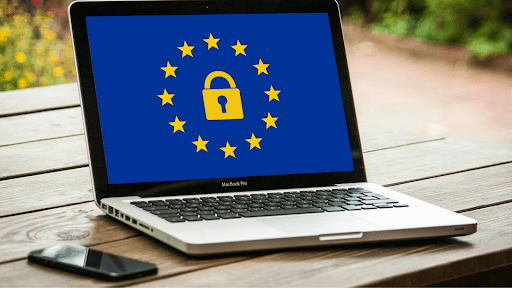
Direct to Customer (or ‘D2C’), is a low barrier-to-entry eCommerce strategy that allows manufacturers and CPG brands to sell directly to the consumer. It removes the middleman (ie. retailer or reseller) to get your product on the market.
>Share this post<

by Lauren Cassidy
January 04, 2021
What exactly is Direct to Consumer eCommerce, anyway?
Direct to Customer (or ‘D2C’), is a low barrier-to-entry eCommerce strategy that allows manufacturers and CPG brands to sell directly to the consumer. It removes the middleman (ie. retailer or reseller) to get your product on the market.We have made several predictions for 2021 which readers can find here, with a surge in D2C uptake being one of the most prominent trends we’re expecting for brands.
While 80% of traditional retailers have seen sales decline since the pandemic started, 52% of D2C brands have seen surges in demand.
While third-party distributors (for example, supermarkets and multi-brand outlets) are likely to always play a part in the consumer sales mix, there’s a lot to be said for brands owning everything from logistics to supply chain and everything in between. This ensures an air of certainty (something much sought after following a turbulent 2020) and allows brands to boost their online sales even more by getting a clear, first-hand look into their customers’ buying behaviour.
Agile D2C and digitally native brands had the upper hand when it came to responding to the pandemic. Forbes discusses their ability to fast-track customer engagement initiatives that were already underway pre-covid. As a result, D2C brands surveyed by Totem Media reported 58% fewer sales declines than traditional retailers since the onset of the global health crisis.
Digital has very much eradicated the needs for a middleman when it comes to eCommerce – but how can this benefit your business? What needs to be considered before testing the waters? We have a full breakdown of the opportunities available to retailers who choose to dabble and how to prepare for the challenges they may face.
While 80% of traditional retailers have seen sales decline since the pandemic started, 52% of D2C brands have seen surges in demand.
While third-party distributors (for example, supermarkets and multi-brand outlets) are likely to always play a part in the consumer sales mix, there’s a lot to be said for brands owning everything from logistics to supply chain and everything in between. This ensures an air of certainty (something much sought after following a turbulent 2020) and allows brands to boost their online sales even more by getting a clear, first-hand look into their customers’ buying behaviour.
Agile D2C and digitally native brands had the upper hand when it came to responding to the pandemic. Forbes discusses their ability to fast-track customer engagement initiatives that were already underway pre-covid. As a result, D2C brands surveyed by Totem Media reported 58% fewer sales declines than traditional retailers since the onset of the global health crisis.
Digital has very much eradicated the needs for a middleman when it comes to eCommerce – but how can this benefit your business? What needs to be considered before testing the waters? We have a full breakdown of the opportunities available to retailers who choose to dabble and how to prepare for the challenges they may face.
What are the benefits of D2C?
Maintaining momentum during a crisis
As we mentioned above, D2C brands were able to steady the ship much more effectively than traditional retailers since the pandemic. The ability to capture sales while other retailers lost ground can be attributed to their strong digital infrastructure. While traditional retailers scrambled to manage store closures and rebalance inventory, D2Cs kept selling online – and with surges in demand.
However, this meant that they felt the brunt of strain on the supply chain – as keeping sufficient inventory in stock proved to be a challenge. That’s not to say that this struggle did not also come with a silver lining. The increased demand exposed many weaknesses retailers who have now been able to identify issues and improve them for future instances.
Maintaining consumer relationships
But why were D2C brands able to respond so well to the crisis? A focus on customer support, being responsive, answering questions in a timely fashion and building trust amidst all the uncertainty enabled these brands to maintain their relationships. This customer nurturing leads to brand loyalty.A recent study found that 59% of consumers prefer to do research directly on the manufacturer’s website, with 55% preferring to make purchases the same way. We’ve discussed this type of focus concerning Nike in a previous post. Nike removed itself from marketplaces like Amazon and invested heavily in its customer experience, making improvements to its eCommerce website and online membership program. These personable approaches simply are not available via third-party vendors.
73% of companies with above-average customer experience perform better financially than their competitors and a D2C module can help retailers differentiate themselves on this front.
Omnichannel Commerce
Another advantage of selling D2C is the potential of selling through omnichannel channels. These brands can set up their online store on a headless commerce platform and even set up their own physical outlets for the unification of off and online.Over the last few years, omnichannel solutions have reinvented the way products are sold online. Consumers now have an experience where they can browse and purchase across multiple channels, choose from a range of delivery options and, if necessary, return it in several ways regardless of which channel through which they originally bought the product.
Shopping online, but in-store at the Circuito de Jerez, Spain.
Through a D2C strategy, retailers can therefore control every step on the consumer journey – from research through to delivery. Some are even expanding their channels into physical stores, redefining the boundaries between brick-and-mortar and online shopping, setting the stage for a retail disruption. Many brands that have started online and extended into offline include Nike, Glossier and Moto GP™.
MotoGP’s omnichannel experience was taken directly to the crowds as Kooomo showcased interactive touch screens at the 2019 race at Circuito de Jerez, Spain. These screens enabled VIP Village visitors to easily buy official MotoGP merchandise, offering a truly unique and seamless shopping experience – but you can read more about that here.
It puts you in control of your data
Control control control. We can’t emphasise enough how much freedom control over all aspects of your business gives you.
Especially when it comes to data. When selling D2C (and on the right platform) you own the data from all of the consumer interactions whether that be sales, customer service or marketing. You quickly get an in-depth understanding of your customers and therefore, how better to serve them.
This kind of data is much more valuable than that of market research, such as focus groups, as it provides direct contact with your customer through every stage of the sale process – even after the goods have been received. Not only can you then improve your CX but deliver content that’s perceived as respectful and relevant to your audiences. Thereby maximising communications and improving relationships as discussed above.
What are some of the challenges to consider?
Liability risks
With full control of your product, there will now be new responsibilities and challenges that you will need to consider. A D2C model exposes a business to risks that are previously or normally bore by distributors such as wholesalers and retailers.
Most notably, data management will be crucial for both your brand reputation and legal issues such as GDPR. You will only be able to reap the benefits of data control if you can make sense of it and interpret it at a high level.
READ: Track & analyse valuable data that will help to shape your eCommerce business strategy.
Security will also be a new factor to consider and plays a major role when consumers build trust with your brand. You will now need to consider the checkout process, ensure the right payments are offered to the right audiences and that each transaction is processed safely and securely.
READ: Provide a seamless purchasing experience that will have them coming back to your store time and time again.
Precision Analytics.
Supply chain processes and systems work a little differently for D2C brands, and companies will need a warehouse network that excels at picking at the sell-unit level, rather than at the case or pallet level. When working with smaller quantities that aren’t shipped to large consolidation points supply chains become piece-specific. Therefore, accuracy is essential.
If companies merely dip their toes in a D2C strategy, it’s not critical to massively redesign the whole supply chain network. However, if the strategy is successful and starts accounting for a significant portion of the business companies will need to rethink their strategy to accommodate the shift. For example, distribution points, contractual arrangements with 3PLs, warehouse designs or the level of automation.
READ: How Kooomo AOM tools empower users to automatically process, manage and fulfil orders.
Organizing and Optimising Product Information
Effective product information management (PIM) is one of the biggest challenges D2C brands face when starting out or making the switch from wholesalers. You might have hundreds or thousands of stock-keeping units (SKUs), which is an enormous amount of content to manage.Content is king when it comes to a successful CX and every product description must be compelling. Every size, colour, and product specification has to be accurate. Not only that, but there is also short term content and sudden changes to consider such as seasonal promotions, or new items they want to bring to market. If this information is inaccurate or out of date, it could lead to lost time and customers.
PIM is a critical aspect of any commerce and a well-defined catalogue enables omnichannel, improved conversion rates, fewer product returns and more.
READ: How Kooomo has brought content and commerce together for the first time.
Conclusion
While there are some pain points involved with getting up and running, the advantages of going D2C are evident. It may take some organisation, but once put in place, a D2C strategy could play a major role in increasing the longevity of your brand, maintaining a glowing reputation and improving relationships with your current and potential customers. So why not cut out the middleman and take your brand by the horns.
So, if you’re thinking about switching to a direct to consumer strategy in 2021, we’re happy to talk you through any questions you might have. Click here to book a 1:1 consultation with a member of the team now!
More to explore
In the next few years, we are foreseeing an impressive increase for the global retail industry. While this can be beneficial for the global eCommerce industry, it also means that there will be more competition, as well.
European Data Protection rules were launched back in 2018, to protect the confidentiality of our personal data but even four years later, there is still a lack of understanding among companies and consumers about how to comply with the best practices. Big tech companies, like Google or Amazon, usually refer to the acronym GDPR, to explain the rules that verify the data, so it is not used inappropriately, but to add details to create confusion.



